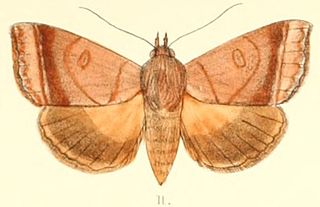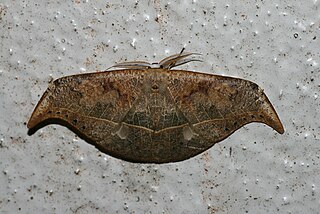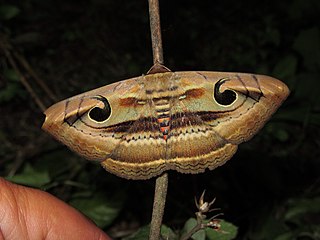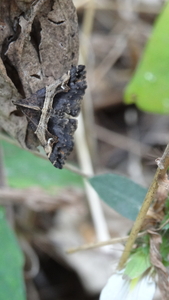
Hulodes caranea is a species of moth of the family Erebidae first described by Pieter Cramer in 1780. It is found from India, Sri Lanka, Myanmar, Java, Hong Kong to Queensland and New Guinea, it is also found on the Marianas and Carolines.

Mythimna decisissima is a moth of the family Noctuidae first described by Francis Walker in 1856. It is found from India across south-east Asia including Hong Kong, Japan, Taiwan and Australia in Queensland and New South Wales. It is also present in South Africa.

Ophiusa trapezium is a moth of the family Erebidae first described by Achille Guenée in 1852. It is found from the Indo-Australian tropics of India, Sri Lanka to Queensland, the Bismarck Islands and New Caledonia. Adults are fruit piercers.

Canucha specularis is a moth of the family Drepanidae described by Frederic Moore in 1879. It is found in Hong Kong, India, southern China, Sundaland and Sulawesi.

Hypena lignealis is a moth in the family Noctuidae described by Francis Walker in 1866. It is found in Sri Lanka, Taiwan and Japan.

Negeta contrariata is a moth in the family Nolidae first described by Francis Walker in 1862. It is found from the Indo-Australian tropics of India, Sri Lanka, Borneo east to Australia (Queensland) and the Bismarck Archipelago.

Gesonia obeditalis is a species of moth of the family Noctuidae first described by Francis Walker in 1859. It is found from eastern Africa, the Seychelles, the Maldives and the Oriental tropics of India, Myanmar, Sri Lanka east to the Philippines, the Sula Islands and Australia. The adult moth has brown wings with a scalloped dark brown band near the margin. The hindwings are similar in pattern to the forewings but are a paler shade of brown.

Maliattha signifera is a species of moth of the family Noctuidae first described by Francis Walker in 1858. It is found in south-east Asia, including China, India, Japan, Taiwan, Korea and Thailand as well as in Australia (Queensland).
Ancylolomia chrysographellus, the angled grass moth, is a species of moth in the family Crambidae. It is found on Cyprus and in Kenya, Uganda, Yemen, India, Pakistan, Sri Lanka, Myanmar, China, Korea, Japan, Taiwan, the Philippines and Indonesia.

Spirama retorta, the Indian owlet-moth, is a moth of the family Erebidae. The species was first described by Carl Alexander Clerck in 1764. It is found in China, Korea, Japan (Honshu), India, Nepal, Bangladesh, Thailand, Cambodia, Myanmar, Vietnam, Taiwan, Sri Lanka, Malaysia, the Philippines (Luzon), Indonesia ,Japan.
Gymnoscelis deleta is a moth in the family Geometridae. It is found in India, Korea, Japan, Taiwan and probably in Sri Lanka according to Hampson.
Carbia pulchrilinea is a moth in the family Geometridae. The species was first described by Francis Walker in 1866. It is found in the Indian subregion, Sri Lanka and New Guinea, as well as on Borneo, the Mentawai Islands and the Bismarck Archipelago. The species is found from lowlands to the upper montane forest zone.
Calamotropha anticella is a moth in the family Crambidae. It was described by Francis Walker in 1866. It is found in South Africa and Sri Lanka.
Culladia admigratella is a moth in the family Crambidae. It was described by Francis Walker in 1863. It has a wide range in the tropics, and has been recorded from the British Indian Ocean Territory, Kenya, Malawi, Mauritius, Nigeria, the Seychelles, Sierra Leone, Socotra, India, Myanmar, the Philippines, Sri Lanka and Sumatra.
Surattha invectalis is a moth in the family Crambidae. It was described by Francis Walker in 1863. It is found in Sri Lanka, India, Java, Indonesia, Myanmar, and Kenya.
Ptychopseustis plumbeolinealis is a moth in the family Crambidae. It is found in India and Sri Lanka.

Bertula abjudicalis is a moth of the family Noctuidae first described by Francis Walker in 1859. It is found in India, Thailand, Laos, Vietnam, Taiwan and from Sri Lanka to Australia, where it has been recorded from New South Wales.
Eupterote plumipes is a moth in the family Eupterotidae. It was described by Francis Walker in 1855. It is found in Sri Lanka.
Pseudojana pallidipennis is a moth in the family Eupterotidae. It was described by George Hampson in 1895. It is found in Myanmar and the north-eastern Himalayas.

Sphingomorpha chlorea, the sundowner moth, is a species of moth in the family Erebidae that is native to Africa and southern Asia. The species was first described by Pieter Cramer in 1777. It is a fruit-piercing moth and a notorious pest in orchards. The fruit is pierced while performing a vertical and rhythmic movement of the head.










